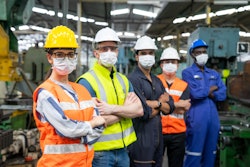
In today’s rapidly evolving supply chain and food logistics landscape, leading a successful operation requires more than adopting the latest equipment or technology. It also requires building and leveraging a workforce of people who can innovate, grow and deliver exceptional results that offer a competitive advantage.
To do this, industry leaders will need to embrace three important keys to workforce development: investing in lean management principles that champion creativity and teamwork, instilling a customer-centric mindset among all employees and instilling a culture of continuous improvement that grows from the bottom up to deliver new and impactful solutions.
Key 1: Invest in lean management
The cornerstone of any effective workforce development strategy involves the adoption of lean management principles that champion your people while reducing inefficiencies.
A common mistake among business leaders and warehouse managers is that the goals of lean management and workforce development conflict with one another. The reality is that lean management principles involve building workforces through eliminating unnecessary waste and highlighting the factors that turn your most valuable asset — your people — into an effective group that consistently outperforms the status quo.
What does this look like in practice? Adopting a lean management mindset starts by empowering members of your workforce to identify challenges and offer solutions. While a top-down view of food logistics operations can reveal inefficiencies between systems, boots-on-the-ground employees, forklift operators, logistics coordinators, safety managers and more are close enough to daily operations to notice persistent, critical problems that slow down processes and produce unnecessary wastefulness.
Of course, shaping a robust and effective workforce involves more than just adopting lean management principles. After all, any manager can tell you that efficiency means little if a culture of teamwork is absent. Bringing teams together to solve challenges allows your workforce to achieve greater results: Cross-functional groups of warehouse floor workers, quality control specialists and supervisors have much to teach and learn from one another; and fostering the kind of deep organizational infrastructure that promotes and makes space for this kind of cross-education is crucial.
The real magic happens when teams trained in lean management principles are encouraged to find innovative ways to address long-standing issues. That kind of creativity can lead to a host of new solutions. For example, a team of warehouse floor workers and quality control specialists might discover new approaches to cold-storage optimization that simultaneously reduce product waste, cut down on energy inefficiency and speed up distribution times.
This kind of ingenuity — a culture of creative, team-driven leanness promoted from the top down to deliver benefits from the bottom up — is the first key to long-term organizational success and a unique, competitive advantage in the food logistics landscape.
Key 2: Focus on customer service
Yes, developing your workforce is key. Yet the ultimate goal of your workforce is to support the most important aspect of any supply chain: the end user, or customer. In all industries, but perhaps especially food and beverage, customer service excellence means rapidly adapting to changing market conditions that impact customer needs in order to stay ahead of trends and potential disruptions.
Those disruptions are everywhere: seasonal demand fluctuations, supply chain interruptions, shipping difficulties, international trade disputes, tariffs, evolving regulatory requirements — the list goes on. Developing your workforce to respond to these challenges in a customer-centric way means educating workers about the principles of flexibility, resilience and innovation. These principles can help them prepare to adapt to changes quickly instead of playing catch-up.
Training your workforce to be flexible and fluid involves helping employees develop both hard and soft skills. Immediate hard skills — such as cross-training for different tasks, roles and responsibilities — can help when disruptions happen on short notice, while soft skills — such as critical thinking, communication techniques, leadership and teamwork development — are crucial for creating long-term adaptability.
Herein lies the secret of the second workforce key: A well-trained, well-developed team that puts the customer first is a team that pivots fast, allocates resources without producing additional waste and keeps everyone — including end-users, industry partners and organizational leaders — satisfied.
Key 3: Instill a culture of continuous improvement
All three keys to workforce development are important, but perhaps the most transformative tool in improving your employee roster involves fostering a consistent culture of continuous improvement among workers.
The key to a culture of continuous improvement lies in the word culture. Disconnected and nonstrategic improvement tactics — like placing suggestion boxes about the warehouse floor or imposing mandatory quarterly brainstorming sessions — are not the most effective methods of encouraging workers to innovate. Instead, it requires embedding improvement-minded thinking into operations that workers engage with every single day, transforming the goal of continuous improvement from a top-down mandate into a persistent habit.
How should organizations embed a culture of continuous improvement within their applications? The answer is simple: by developing great teams. Teams consistently improve on outdated principles better than individual workers because of the diverse perspectives, problem-solving abilities and sense of shared accountability they exercise when together.
How many times have your teams innovated organically? Many industry leaders are surprised to recall the amount of times their workforces smartly adapted to changing circumstances: A cross-functional team examining shipping efficiency found that better coordination between drivers and managers led to reduced wait times on the floor; and a group of inspectors working in cold storage discovered the power of using new technology to share insights and reduce waste. Clearly, moments like these happen all on their own, and the trick is to willfully build an environment where they happen purposefully, strategically and, best of all, frequently.
Continuous improvement works well with the concept of kaizen, a principle based on the idea that small changes over time result in significant improvements. The goal of kaizen is to strengthen processes in incremental ways to establish increased customer value, allowing workforces to remove frustration and provide more time to spend on value creation. This practice may seem counter to traditional organizational overhauls but often leads to more creativity and innovation among employees, who learn to become architects of improvement themselves instead of simply executing on principles developed by management.
Implementing the 3 keys of workforce development
As the food logistics and supply chain management industries continue to evolve, bolstering the most important aspect of your organization — the adaptable and intelligent workforce that applies lean management principles to both structural and day-to-day challenges — serves as a crucial market differentiator. While many industry leaders might believe new technologies, machinery or equipment are the keys to success, a developed workforce possesses one quality no product innovation can replicate: the ability to continuously and relentlessly improve through the power of human ingenuity.



















